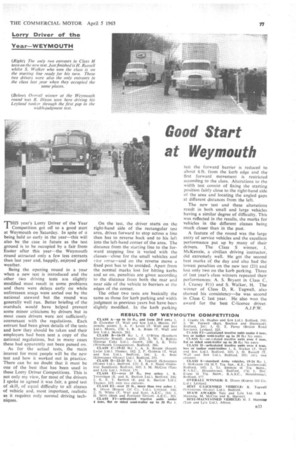Good Start at Weymouth
Page 79

If you've noticed an error in this article please click here to report it so we can fix it.
TH"year's Lorry Driver of the Year Competition got off to a good start at Weymouth on Saturday. In spite of it being held so early in the year—this will also be the case in future as the test ground is to be occupied by a fair from Easter after this year—the Weymouth round attracted only a few less entrants than last year and, happily, enjoyed good weather.
Being the opening round in a year when a new test is introduced and the other two driving tests are slightly modified must result in some problems and there were delays early on while unforeseen snags were sorted out by the national steward but the round was generally well run. Better briefing of the marshals would have helped prevent some minor criticisms by drivers but in most cases drivers were not sufficiently conversant with the regulations. Each entrant had been given details of the tests and how they should be taken and their employers had been sent a copy of the national regulations, but in many cases these had apparently not been passed on.
As for the actual tests, the main interest for most people will be the new test and how it worked out in practice. There can be no doubt that it must be one of the best that has been used in these Lorry Driver Competitions. This is not only my view, for most of the drivers I spoke to agreed it was fair, a good test of skill, of equal difficulty to all classes of vehicle and, most important, realistic as it requires only normal driving techniques.
On 'the test, the driver starts on the right-hand side of the rectangular test area, drives forward to stop across a line then has to reverse back and to his left into the left-hand corner of the area. The distance from the starting line to the forward stopping fine is varied with the classes—close for the small vehicles and vice rersa—and on the reverse move a fixed post has to be avoided. Apart from the normal marks lost for hitting kerbs and so on, penalties are given according to the distance from both the rear and near side of the vehicle to barriers at the edges of the corner.
The other two tests are basically the same as those for kerb parking and width judgment in previous years but have been slightly modified. In the kerb parking test the forward barrier is reduced to about 6 ft. from the kerb edge and the first forward movement is restricted according to the class. Alterations to the width test consist of fixing the starting position fairly close to the right-hand side of the area and locating the angled gaps at different distances from the left.
The new test and these alterations result in both small and large vehicles having a similar degree of difficulty. This was reflected in the results, the marks for vehicles in the different classes being much closer than in the past.
A feature of the round was the large entry of service vehicles and the excellent performance put up by many of their drivers. The Class S winner, J. McKenzie, a civilian driving instructor, did extremely well. He got the second best marks of the day and also had the lowest penalties on the new test (21) and lost only two on the kerb parking. Three of last year's class winners repeated their performances: A. S. Bryant in Class C, Craney F(1) and S. Walker, H. The winner of Class D, R. Tugwell, also showed his consistency—he was second in Class C last year. He also won the award for the best C-licence driver. A.J.P.W.








































































































































